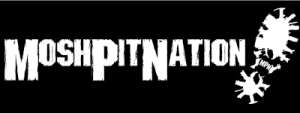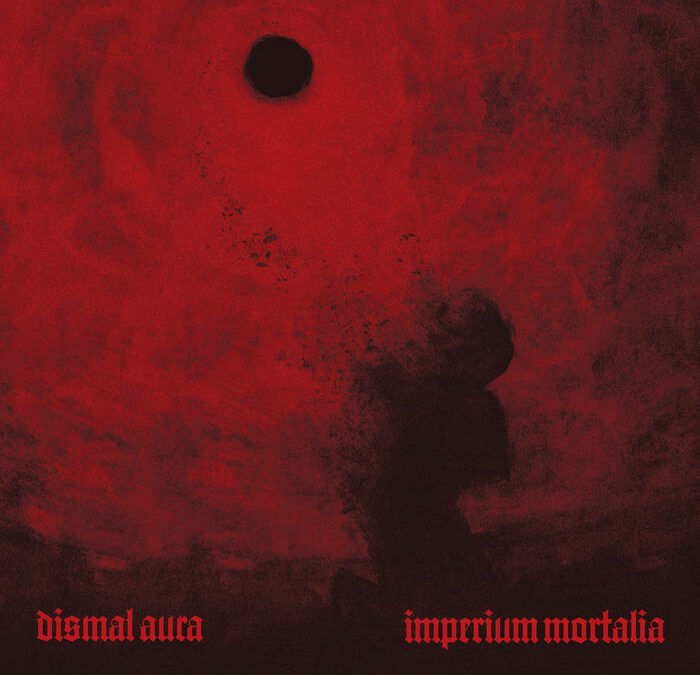Band – Dismal Aura
Album – Imperium Mortalia
Country of Origin – Canada
Genre – Black Metal
Release Date – September 29, 2023
Label – Avantgarde Music
Author – Hayduke X
Review
New to me with this release, it turns out that Imperium Mortalia is the third overall release by Dismal Aura, and the second full length. I definitely have some catching up to do. I was immediately captured by the explosive black metal on display through these eight tracks. The album actually includes some death metal influence as well, but is black metal first. Maybe deathened black metal is a fair description.
Though the album is explosive, there is plenty of room for nuance, as intelligent riffs (Archon Lamentor) interweave with subtle keys (Hlystlif), earthquake inducing bass (Kìminidjàgan), and thoughtful, but relentless drums (Hlystlif again). Archon Lamentor and Kìminidjàgan share vocal duties, which are primarily, but not exclusively, an inferno of impassioned, broken-glass spewing shouts and yells – very effective for the music.
Thematically, Imperium Mortalia is inspired by the essay “Necropolitics” by Achille Mbembe, an historian, political theorist, and intellectual from Cameroon. I will not attempt to summarize the essay here, but it is well worth the read. I will quote the opening line:
This essay assumes that the ultimate expression of sovereignty resides, to a large degree, in the power and the capacity to dictate who may live and who must die. (Achille Mbembe, “Necropolitics,” Public Culture, 15:1, Winter 2003, p. 11)
It strikes me that this sort of sovereignty is the sovereignty of oppression. The power to choose who lives and dies is, by nature, an oppressive power. It is equally clear to me that Dismal Aura stands against this oppression, that the album seeks to shine a light on it, not to celebrate it. The promotional materials list the themes as “colonialism, state-terror, and environmental destruction.” I don’t have lyrics, but this, along with the song titles make this clear.
Imperium Mortalia is a revelation. The excellence of performance and composition, the perfection of the mix, the relevance and power of the themes, all make this an important work. Not only this, but the album is musically dynamic. I hope it finds its way to a lot of ears and onto a lot of year end lists. Dismal Aura deserves it.
Interview
(AL) – Archon Lamentor: Guitar, vocals.
(K) – Kìminidjàn: Bass, vocals.
(H) – Hlystlif: drums, keyboards, vocals.
Hayduke X: Congratulations on the release of Imperium Mortalia. The album immediately impressed me. Can you start by introducing yourselves (posted above) and sharing how you feel about the finished product?
AL: It was important to us to spend as much time as was necessary on both the lyrical themes and production. It was a great experience working with Mike Bond and Topon Das, who are pillars of the Ottawa heavy music community and we are very happy with their efforts. It took longer than expected, but it was worth it to get it right.
HX: Tell me about the formation and history of the band. It’s my understanding that Kìminidjàgan is also a member of the band Longhouse. Is there a connection between the two?
K: This is a great example of how interconnected the metal community is in our town. Myself and Archon Lamentor originally connected through our respective doom projects. Longhouse invited AL to co-author and perform on a track from our last album. Through that writing process and sharing the stage on a short-run of shows on the road we remained connected, which would eventually result in the invitation being extended to join Dismal Aura.
HX: How has the band evolved since the release of Praesagia Tristia?
H: We’ve grown a lot since Praesagia Tristia. One of the major changes is that we enlisted more help. Asking for help isn’t always easy, especially in an era where you are expected to do it all yourself, but I’m very pleased we did. The sound has evolved to be much fuller and richer, and we allowed more space for somber passages for contrast. Working with two producers (Topon Das, Mike Bond) was a change; they did a fantastic job of ushering our sound to the next level.
HX: The press materials state that the band is composed of members “with diverse cultural backgrounds.” What can you tell us about those backgrounds?
K: The other part of that statement is “and lived experiences” which truly grounds the band in how we approach the subject matter of our music and how we conduct ourselves in the community. As an example, I am a proud Anishinàbe Algonquin person from Ottawa, and a member of Kitigan Zibi Anishinàbeg. It’s important that I conduct myself in a way that upholds my responsibility to these communities and my values as an Indigenous person. My relationship to my community and the world around me also informs my creative process.
HX: The press materials also state that the band “explores socio-political topics such as colonialism, state terror, and environmental destruction.” Can you expand on that in terms of your lyrics and themes?
AL: During the formation of the project we discussed how we would approach lyrical content, and it quickly emerged that we were not interested in pursuing typical black metal themes. Put another way, black metal has always been involved in a bit of an arms race to be the darkest, scariest version of itself. While that journey has led to some very creative explorations of Satanism, the occult, and nihilism, our path has been to explore modern examples of the suffering and injustices that humankind inflicts upon itself. That certainly makes for some
extremely dark subject matter. Briefly, on this record we directly discuss topics like our country’s legacy of settler colonialism (Blood Quantum), early 20th century movements for labour rights (Les Allumettiers), the church’s history of persecuting queer populations (And Their Blood Shall Be Upon Them), and modern exploitations of stateless people for political gain (Weaponizing Human Suffering). Other songs more abstractly explore the sometimes hopeless feeling of living in modern democracies (One Path, Many Voices) and call for continued resistance against systems of power and exploitation (Beyond Necropolitics).
HX: Though you incorporate other elements into your music, you are first andforemost a black metal band. Black metal as a genre is notorious for having a Nazi problem in the scene. What’s your take on nsbm? Is that a problem in your region?
AL: My first instinct is to reach for Durkheim and point to the anomie or disconnectedness that human beings as social animals may feel in complex modern societies. The way many of us live now – in cities of millions – is very new. Humans evolved to live in much smaller social groups with shared values that were easier to recognize and communicate to others, and some people feel very confused and isolated living among massive populations of people with overlapping or perhaps conflicting cultures and values. One way of (over)reacting to that confusion is to hyper-identify oneself by attacking people who are different. There is comfort, however malignant, in joining a group of “Us” to rally against “Them.” So from that view, I can at least understand the impulse with a grudging sense of pity.
My second, less sociological response would be to point out that human beings are very stupid and violent creatures, and that my evidence for that statement is the whole of human history. So I’m not surprised that there are stupid people who want to do violent things, or even to dress up and sing about them. I think it’s safe to say you don’t really get into black metal without eventually coming across this problem, and so from the start we made it very clear that we wanted to carve out a space for people who like their heavy music without any of that nonsense, and we will continue to be very vocal about that.
HX: In a podcast I listened to with an interview with Kìminidjàgan, who was speaking for Longhouse at the time, he spoke about Indigenous issues in Canada? Does Dismal Aura confront those issues as well? In what ways?
K: Yes, we confront issues impacting Indigenous Peoples in Canada and North-America in a similar way. The main difference is that Kìminidjàgan also uses Longhouse as a vehicle to diarize his journey of connecting more deeply with his culture and understanding of traditional knowledge, whereas, with Dismal Aura we have stronger focus on human and social injustices such as land-theft, colonization, and genocide – such as in our songs ‘Terra Nullius’ from our first record, and ‘Blood Quantum’ from Imperium Mortalia.
HX: What is your songwriting process as a band?
H: Archon Lamentor will bring a demo to the table, often many. After we have gone back and forth about the arrangement we will distribute lyric-writing duties. It’s a pretty simple process and we are fortunate to have such a good rapport. We have several demos for the next record already.
HX: Tell me about the cover art. Who designed it? How do you feel it fits with the music?
K: The cover art was designed by MosaEye. We felt it matched the grim and uncertain socio-political landscape painted throughout the album. In the foreground we see a form who is presumably on their knees. We do not know whether it is in subservience or reverence, we don’t know if they are being pulled apart by what might be a cosmic storm, or being called to a higher plane of existence to be free from the suffering of the human world. What we do know is that if we look closely, through the surrounding turmoil, we can perceive that they are not alone.
HX: You are releasing this album through Avantgarde Music, a label based in Italy. How did that all come about?
H: Hard work with a dash of luck. After completing the album we looked into labels we were interested in, shopped it around, and waited. We heard from Avantgarde Music, and it was fortunate that Andrea, who contacted us, shares our anti-fash approach. For myself, AGM has always been a safe bet for finding new bands, and I recall fondly the album covers that drew me to new artists, often great and always weird. They also released my favourite black metal album of all time, “Death’s Design”, the final masterpiece from Diabolical Masquerade.
HX: Does Dismal Aura have a live presence? What could we expect at a live show? Will you tour in support of this release and can we convince you to come to Michigan?
AL: We’ve played a handful of local shows and are heading out to play some dates in Ontario and Quebec in October and November this year. We hope to do some international dates in the near future.
HX: What’s next for Dismal Aura?
AL: We’ve been working on new material while preparing Imperium Mortalia for release. We have about four songs arranged in basic form and I have a pile of cassette demos to work from, so the seeds of the next record have been planted. In the meantime, we’re hoping to travel more, get some creative merch happening, and possibly produce a live video performance.
![]()
Biography: Hayduke X has been writing for MoshPitNation since June of 2016. He is also a contributor to The Metal Wanderlust. Prior to joining the MoshPitNation team, Hayduke published reviews on his own blog Rage and Frustration. In addition, he has DJ’ed an online metal radio show of the same name as his blog, written for TOmetal.com, done interviews for Metal Rules, and collaborated with The Art of B Productions to create video interviews with a wide variety of bands.

